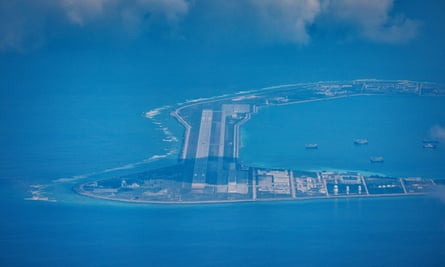The Philippines has granted the United States expanded access to its military bases, greatly enhancing Washington’s presence in the region at a time of growing concern about Chinese aggression.
Washington would be given access to four additional military bases in “strategic areas of the country”, without specifying the locations, the Philippines’ Department of National Defence said on Thursday in a statement.
The expanded access will fill a crucial gap in US positioning in the region, say analysts, and enable it to better monitor Chinese activity in the South China Sea and near Taiwan.
The deal has been made under an Enhanced Defense Cooperation Agreement (EDCA) that allows the US access to Philippine bases for joint training, storing equipment and supplies and building of facilities such as runways, though not to establish a permanent presence. The US already has access to five sites.
In its statement, the Philippines Department of National Defense said that Washington would allocate more than $82m toward infrastructure investments at the five previous bases it was given access to. “The Philippine-US alliance has stood the test of time and remains ironclad,” its statement said.
It has been widely reported that the US asked for access to bases on Luzon, the closest part of the Philippines to Taiwan, and on the island of Palawan, the closest landmass to the disputed Spratly Islands in the South China Sea.
Such sites were valuable for two reasons, said Denny Roy, senior fellow at the East-West Center, Honolulu. “They are geographically close to the top two flashpoints involving China: Taiwan and the South China Sea. This is especially true of northern Luzon,” he said, adding. “Second, additional places in the area where the USA can pre-position forces helps to lessen the problem of concentrating too many forces in a small number of places that might be vulnerable to Chinese missile attacks.”

The location in Luzon would allow the US to provide operational and logistical support to Taiwan, if needed, said Herman Kraft, professor of political science at University of the Philippines. For now, the access would most likely be used for monitoring purposes, he said.
The expanded access fills a missing link in terms of US positioning in the region that dates back to 1991, when the Philippines refused to ratify a new agreement with Washington, its former colonial ruler, forcing them to leave, said Kraft. “South-east Asia has always been more or less a gap [for the US],” said Kraft. “They do have a deployment arrangement with Singapore, but it’s a small one.”
The announcement comes amid concerns over China’s assertiveness in the disputed South China Sea, a major potential flashpoint. The Philippines, as well as Vietnam, Malaysia and Brunei all have claims to parts of the sea, while Beijing claims sovereignty over almost all of it.
A report by the Asia Maritime Transparency Initiative at the Center for Strategic and International Studies, found the China Coast Guard (CCG) maintained near-daily patrols at key features across the South China Sea in 2022, and that its presence was “more robust than ever”.
The report, which analysed automatic identification system (AIS) data from commercial provider MarineTraffic, found that the number of calendar days that a China Coast Guard vessel patrolled key features had increased across the board when compared with data from 2020. Features studied included Second Thomas Shoal, Luconia Shoals, Scarborough Shoal, Vanguard Bank, and Thitu Island.

 1 year ago
76
1 year ago
76










 English (US)
English (US)